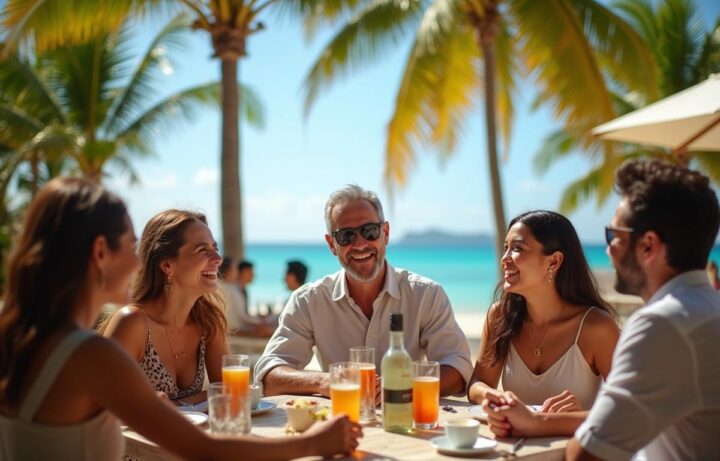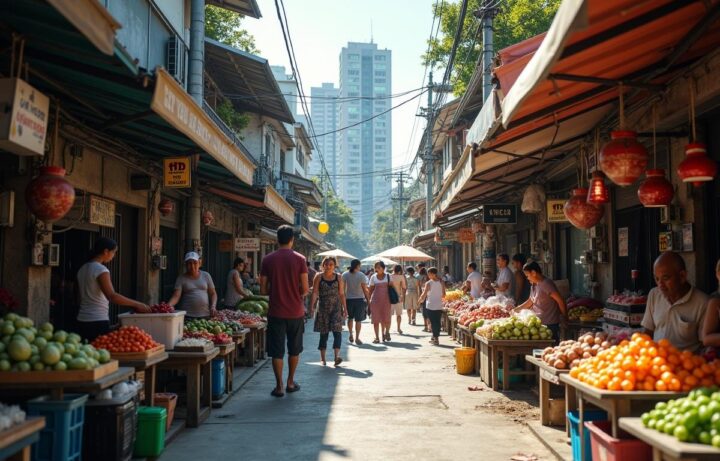Cost of Living in Philippines Might Surprise You
Standing at the 163rd most affordable country worldwide, the cost of living in Philippines is reasonable. Monthly living expenses average $594, a stark contrast to America’s $2,498. These numbers paint only part of the picture.

Life in the Philippines comes with its share of unexpected costs. A typical family needs about $1,940 monthly without rent, while singles can manage with $562. Expats often face surprising expenses that basic cost calculators miss. Monthly utility bills can reach 6,108.89?, and imported products command premium prices that catch many newcomers off guard.
This piece uncovers the true expenses and financial hurdles that await future residents of this Southeast Asian archipelago.
The Real Cost of Housing in Philippines: Beyond the Listings
Looking at housing prices in the Philippines might make you think you’re getting a great deal. Property listings show rental rates that look good on paper. The real cost of living here comes with many extra expenses that you won’t see in ads. Your budget needs to go beyond the basic rent – from utility bills that can double without warning to extra fees that pop up after you sign a lease.
Unexpected utility fluctuations in Manila
People living in Manila pay some of the highest electricity rates in Southeast Asia. A family’s typical monthly power bill runs about 2,000 Philippine pesos for 200 kilowatt-hours. This jumps to 11,120 pesos if you use 1,000 kilowatt-hours. The residential electricity price sits at 11.601 PHP per kWh or USD 0.202 – that’s 125.34% above what most people pay worldwide.
Summer hits hard on your wallet from March to May. A standard 85m² apartment’s monthly utilities (electricity, heating, water, garbage) usually cost 5,620 PHP. This can shoot up to 7,610 PHP in peak season. High-speed internet adds another 1,600-2,500 PHP monthly. These utility costs make up a big chunk of your living expenses here.
Expats coming from places with steady utility rates often get a shock. Even though rent costs less than in Thailand, these utility bills can eat up any money you thought you’d save.
Hidden fees in condo rentals
That attractive rental price you see for condos doesn’t tell the whole story. A one-bedroom in Manila’s city center averages 25,000 PHP, but you’ll need to budget for many more expenses.
Association dues hit your wallet hard. Studio owners in Metro Manila shell out 80-150 PHP per square meter monthly. A small 25-square-meter studio adds 2,000-3,750 PHP monthly just to keep common areas running.
You’ll also need to watch out for:
- Move-in fees that cover electricity hookup, water services, and advance property taxes
- Premium units ask for reservation fees between 10,000-25,000 PHP
- Notary fees cost about 1-2% of what the property’s worth
- Monthly parking spots add 3,000-5,000 PHP more
Retirees planning to stay long-term should take note. These hidden housing costs can really change your monthly budget in the Philippines.
The true price of beachfront living in Cebu
A beach house in Cebu sounds perfect, but what’s the real cost? The province offers better deals than Manila, but prime spots by the beach come at a premium.
Mactan Island’s beachfront condos start at 9.4 million PHP to buy, while monthly rent begins around 40,000 PHP for nice places. Luxury spots like Sheraton Cebu Mactan Resort properties can cost up to 20.9 million PHP. These target well-off expats who want top-notch amenities.
Living by the beach in Cebu means higher utility bills too. A family in Cebu City spends about 60,000 PHP monthly. Beachfront properties usually cost 10-15% more because they need extra cooling and premium services.
The good news? Compared to other countries’ beachfront spots, Cebu gives you more bang for your buck. Housing costs 47% less than Makati. This makes it perfect for digital nomads who want affordable tropical living close to city conveniences.

Food and Grocery Expenses: Local vs. Western Habits
Food costs are the foundations of living expenses in the Philippines. My experience living in regions of all sizes over four years has taught me that grocery habits affect monthly expenses by a lot – sometimes even more than housing costs.
Market shopping vs. supermarket costs
Traditional wet markets or “palengkes” are the heart of Filipino food shopping and offer big savings compared to supermarkets. Your monthly expenses can drop by up to 30% if you shop at local markets. Recent food pricing data shows that the minimum monthly food budget is ?8,950.85 for Asian food patterns, but this jumps to ?12,699.36 for Western eating habits.
Local palengkes give you more than just lower prices. You’ll find fruits, vegetables, and seafood straight from farms and fisheries early in the morning at peak freshness. Grocery stores get their items later and might display them for days.
Let’s look at some real-life price differences:
- White onions: ?192/kg at supermarkets vs ?67/kg at wet markets
- Potatoes: ?210/kg in supermarkets vs ?57/kg at wet markets[111]
- Fresh fish: Wet markets sell it 40-50% cheaper, especially early morning
Expats used to clean supermarket shopping might find wet markets challenging at first. You’ll need to learn haggling skills, know Filipino vegetable names, and build relationships with trusted vendors or “sukis”. Many expats in Manila, Cebu, and other cities end up with a mixed approach – they buy non-perishables at supermarkets and fresh produce from local markets.
Shopping habits make a big difference to your expenses. One expat puts it well: “5,846 pesos for food will last about a week with Western standards, but could stretch to nearly a month if you eat like locals”.
The expat tax: premium on imported goods
Living costs take an interesting turn when you add imported food to your shopping list. Many newcomers get quite a shock.
Locals joke about the “expat tax” – the big markup on imported foods. The Philippines has a 6.1% average tariff (9.8% for agricultural products), but imported goods cost way more than in Thailand and nearby countries.
Dairy products show this price gap clearly. Local cheese costs about ?201.16 per pound, but imported varieties often cost 2-3 times more. A 370g box of imported cereal might set you back ?180.50 – too expensive for most locals but tempting if you’re missing home.
Different supermarkets target different customers. The Marketplace caters to upscale shoppers and expats, while Puregold and SaveMore focus on budget-conscious locals. Retirees watching their budget quickly learn which stores offer better deals.
Rural residents face extra challenges to get imported goods. They must travel to cities or pay extra for delivery. Online grocery services have grown since the pandemic but charge ?88-?200 for delivery, which eats into any savings.
Your living costs become more manageable when you adapt to local food choices. Rice, local vegetables, and fresh seafood make better staples than imported alternatives.
Transportation Realities and Hidden Costs
Transportation costs are one of the most overlooked parts of living expenses in the Philippines. I found that there was a surprising chunk of my monthly budget went to getting around after spending years navigating this archipelago. Hidden expenses can really add up.
Vehicle ownership expenses most expats underestimate
A vehicle’s true cost in the Philippines goes way beyond the reach and influence of its purchase price. Private car owners must pay around ?1,600 to the Land Transportation Office for their original registration. They also need ?650 for mandatory Compulsory Third Party Liability (CTPL) insurance and ?500 for smoke emission testing. These annual expenses catch many expats off guard.
Vehicle upkeep takes a big bite out of your wallet. The first 1,000 to 5,000 kilometers need preventive maintenance that costs ?3,600 to ?5,700 yearly. This amount jumps to ?12,300 once your vehicle hits the 25,000-kilometer mark. Car insurance premiums also run between ?14,000 to ?23,000 yearly for a basic Toyota Vios.
Gasoline expenses play a huge role in Philippines’ living costs. Fuel runs about ?38.75 per liter and costs pile up fast, especially in Manila’s congested streets. Filling up a tank (42 liters) every two weeks adds up to ?57,456 yearly.
Island hopping transportation budgets
The Philippines’ monthly living costs include a unique expense – island transfers. The country’s geography makes water and air transport necessary between major islands, unlike Thailand where people mostly travel by land.
Ferry rides cost different amounts based on distance. A two-hour trip on an air-conditioned express catamaran usually runs between ?300-400 (USD 6-8). Budget airlines connect major spots like Manila, Cebu, and Siargao, but last-minute bookings can cost an arm and leg.
A one-way ticket from Manila to Coron costs about USD 103, while Cebu to Siargao flights run around USD 78. Moving between islands frequently can double your travel budget.
Getting around in rural Philippines: the real costs
Rural areas have their own transportation story. Tricycles rule the roads in provincial regions, where drivers charge about ?15-20 daily (USD 15-20) for touring services.
Better roads have helped cut travel costs in some areas. To cite an instance, see South Cotabato, where improved farm-to-market roads dropped farmers’ transportation costs from ?50 to ?20 per bag of produce. This shows how reliable infrastructure affects living expenses.
Public transport remains a bargain compared to city prices. Jeepney rides start at just ?9-11 and busses cost ?12-25. Retirees in rural Philippines save money compared to Manila, where monthly transportation passes cost around ?1,530.

Healthcare and Insurance: What is the Cost of Living in the Philippines When You Get Sick
Healthcare costs can wreck your budget in the Philippines. These expenses often go way beyond what most digital nomads expect. My personal experience with the healthcare system shows that medical expenses are a big deal when calculating living costs in the Philippines. Most expense calculations leave this part out.
Quality healthcare access costs
Public and private healthcare prices create a tricky money situation. A hospital room will set you back ?500 per day for simple wards. Private rooms cost up to ?6,000. You’ll pay around ?2,500 for one night at the hospital. A quick visit to the doctor costs about ?500.
Medical procedures in the Philippines are nowhere near as expensive as Western countries. A knee replacement costs about $9,000 here compared to $34,000 in the US. Heart procedures like coronary artery bypass grafting cost $18,140, while the same procedure in America runs up to $88,000. These lower prices bring medical tourists to Manila and Cebu. The costs still hit expats with fixed incomes pretty hard.
Insurance options and limitations
Living costs in the Philippines jump up fast without good health coverage. PhilHealth, the national insurance system, is cheap at ?2,400-?3,600 yearly. The problem is it covers only part of the expenses. Many Filipinos end up paying huge out-of-pocket costs.
International health insurance costs expats about $4,428 yearly for single coverage and $12,199 for families. Younger expats get better deals. A 30-year-old can find coverage from $32 monthly, while a 65-year-old pays from $112 monthly. Cigna, Allianz, and Pacific Cross are popular choices. They offer different coverage levels that fit various budgets.
Medical costs in the Philippines keep climbing. The inflation rate sits at 18.3% for 2025—the second-highest in Asia. This makes detailed insurance coverage crucial if you’re planning to retire here long-term.
Emergency evacuation considerations
Rural Philippines brings an extra challenge that many people overlook – emergency medical evacuation. Unlike Thailand where ground transport works fine, island geography means you might need air evacuation to Manila or even other countries.
Air ambulance evacuations can hit $300,000. Helicopter medevacs cost around $60,000. Even regular ground ambulances cost up to $5,000. Many expats buy special evacuation insurance like Global Rescue. Memberships start at $139 yearly. This protection keeps you safe from expenses that could bankrupt you.
Banking, Visas, and Administrative Expenses
Banking and administrative expenses rarely get attention when people calculate their cost of living in the Philippines. Your wallet takes a hit every time you withdraw cash, transfer money, or handle visa paperwork. These small costs add up faster than you might expect.
ATM and money transfer fees
The ATM becomes your first money drain. Philippine banks charge foreign cardholders PHP 150-300 per transaction, with most banks setting the fee at PHP 250. All but one ATM nationwide charge these fees.
Moving money internationally takes a big chunk from your monthly expenses in the Philippines. Wise takes about 0.58% in fees to send $30,000 USD to PHP. Traditional services make it worse by hiding markups in their exchange rates. Regular transfers from abroad can cost expats hundreds of dollars each year.
Bank maintenance charges put extra pressure on your finances. Minimum balance penalties range from PHP 55 for pensioner accounts to PHP 500 for regular corporate accounts. Your peso accounts will face PHP 30 monthly charges if they stay inactive for five years.
Visa renewal costs compared to Thailand
Visa fees make up a large part of living costs in the Philippines for people staying long-term. The original one-month tourist visa extension costs PHP 3,000-4,000. You’ll need an Alien Certificate of Registration (ACR) card for later extensions, which costs about PHP 2,500.
Thailand offers better rates, where a single-entry tourist visa costs MYR 160 (about PHP 2,000) and stays valid for 90 days. This difference matters to retirees in Manila or Cebu who plan their long-term budgets.
The price of paperwork assistance
Rural Philippines demands professional help for administrative tasks, especially if you’re new to local procedures. Lawyers charge at least PHP 2,500 per hour. Document preparation costs between PHP 500-5,000 based on how complex the paperwork is.
Major banks charge PHP 200 for notarizing lost passbooks. Bank certifications for visa applications cost PHP 100-200. Expats often pay extra to speed up their paperwork, with consular services charging USD 10 for same-day processing.
Cost of Living in Philippines Frequently Asked Questions
Is USD 1,000 per month enough to live comfortably in the Philippines?
While USD 1,000 can cover basic living expenses in the Philippines, especially in provincial areas, it may be tight for a comfortable Western lifestyle. This budget can cover rent, food, and basic utilities, but you may need to make some lifestyle adjustments and be mindful of your spending.
Where are the most affordable places to live in the Philippines on a budget?
Provincial areas and smaller cities tend to be more affordable than major metropolitan areas. Places like Bulacan, Pampanga, Cebu, and parts of Mindanao offer a lower cost of living while still providing access to amenities. Avoid tourist hotspots and big cities like Manila or Makati for more budget-friendly options.
What are some unexpected costs expats should be aware of when living in the Philippines?
Some hidden expenses include visa renewal fees, fluctuating utility costs (especially during summer), condo association dues, imported goods premiums, and potential healthcare costs. It’s also important to budget for transportation, especially if living in areas with limited public transit options.
How does the cost of healthcare in the Philippines compare to Western countries?
While healthcare in the Philippines is generally more affordable than in Western countries, quality can vary. Private hospitals in major cities offer good care but can be expensive without proper insurance. It’s advisable to have comprehensive health insurance, including coverage for medical evacuations, which can be costly.
Can expats find affordable housing in major Philippine cities?
Affordable housing options are available in major cities, but they may require compromises on size, amenities, or location. Studio apartments or shared accommodations can be found for reasonable prices, even in areas like Quezon City or parts of Metro Manila. However, prices in prime areas like BGC or Makati tend to be significantly higher.
What is the average monthly cost of living for a single person in the Philippines?
For a single person, the cost of living in the Philippines can vary widely depending on location and lifestyle. On average, you might expect to spend between USD 500 to USD 1,200 per month. This includes rent, utilities, food, transportation, and leisure activities. Living in smaller cities or provincial areas will be on the lower end of the spectrum, while living in larger cities like Manila or Cebu will push the cost higher.
How much does it cost to rent an apartment in the Philippines?
Renting an apartment in the Philippines can range from as low as USD 100 to USD 400 per month for a small, basic apartment in less urbanized areas. In more popular cities like Metro Manila or Cebu, rent for a one-bedroom apartment can range from USD 300 to USD 700, depending on location and amenities. Luxury apartments in prime areas like BGC or Makati will cost significantly more.
Are groceries expensive in the Philippines for expats?
Groceries in the Philippines are generally affordable, especially if you buy locally produced items. Imported goods, however, tend to be more expensive due to higher taxes and shipping costs. A monthly grocery bill for one person can range from USD 100 to USD 300, depending on dietary preferences. If you’re looking for Western food, expect to pay a premium for items like cheese, meats, and certain fruits.
How much do utilities cost in the Philippines for a typical apartment?
Utility costs in the Philippines can vary, but on average, you might pay between USD 50 to USD 150 per month for basic utilities such as electricity, water, and internet. The biggest variable is electricity, especially if you use air conditioning regularly. Utility costs are usually lower in rural areas compared to urban centers.
Is public transportation affordable and reliable in the Philippines?
Public transportation in the Philippines is generally affordable, with options like jeepneys, buses, and tricycles costing as little as USD 0.25 to USD 1 per ride. However, reliability can be an issue, particularly in major cities where traffic congestion is a regular problem. In larger cities like Metro Manila, you may also have access to the MRT (Metro Rail Transit) or LRT (Light Rail Transit), which are efficient but can get crowded during rush hour.


